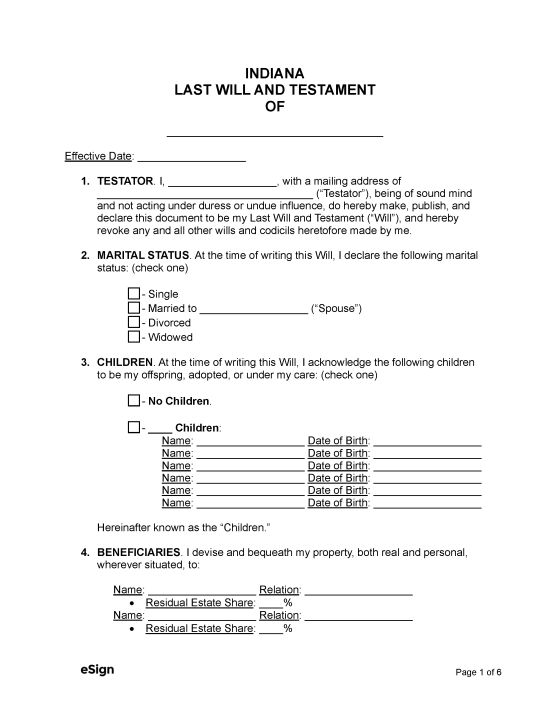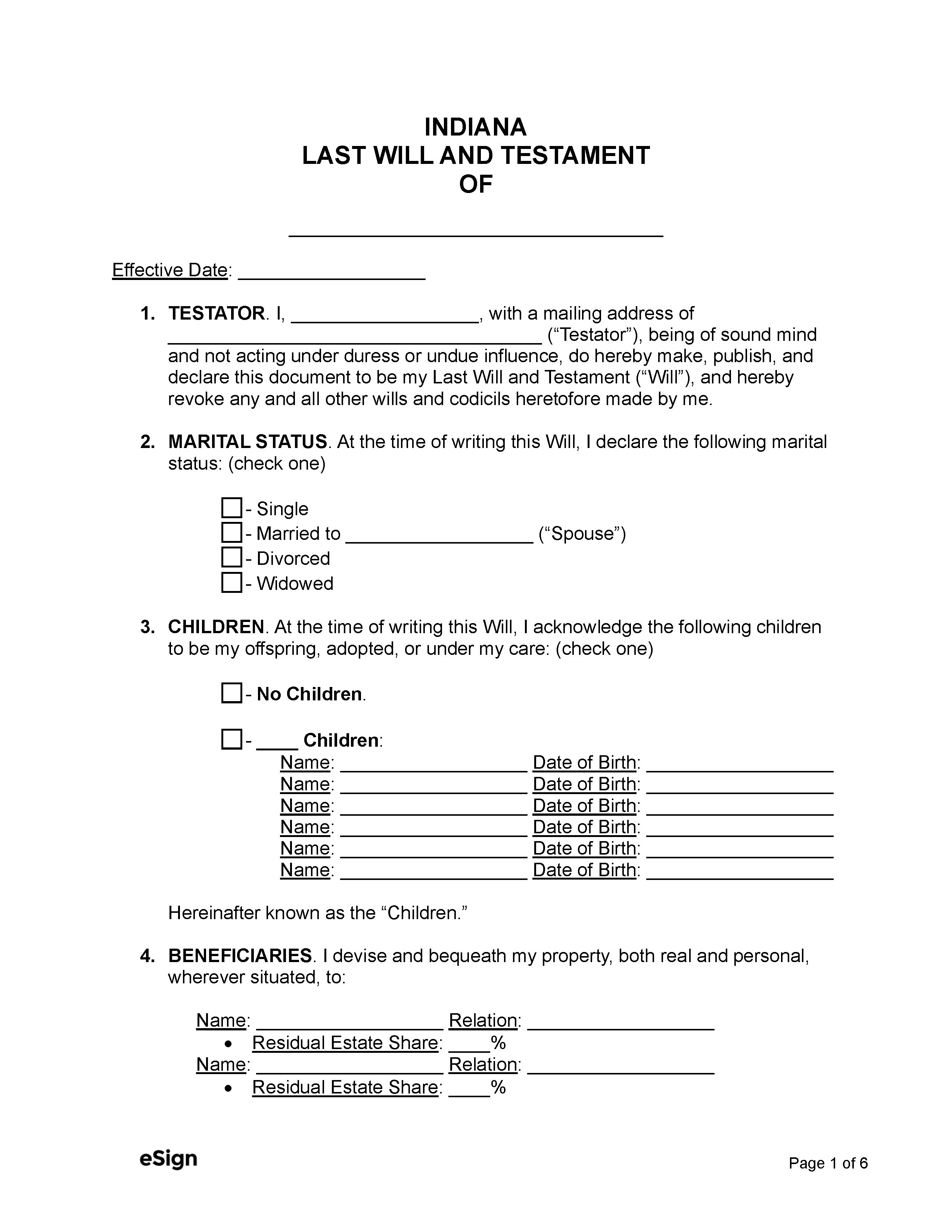State Laws
State law requires an individual to be at least 18 years old to make a will. This age requirement doesn’t apply to members of the armed forces, U.S. merchant marines, or allied forces.[1]
Holographic Wills – State law requires that all wills, including handwritten ones, meet the same statutory requirements.[2]
Revocation – The testator can revoke their will by destroying it or by executing a subsequent will or document that revokes it.[3]
Signing Requirements – The signing of a will is required to be witnessed by two or more parties who must also sign.
Probate Process in Indiana (9 steps)
At the time of the decedent’s death, the person with the will in their possession must submit it to the court within a reasonable time or risk being held in contempt.[4] To be admitted for probate, most wills must be submitted within three years of the decedent’s death date.[5]
- Begin Unsupervised Administration of the Will
- Notice of Petition
- Court Order & Letters Testamentary
- Post Bond (If Applicable)
- Notices & Publication
- Estate Inventory
- Debts & Taxes
- Distribution of Remaining Assets
- Closing Affidavit & Discharge
1. Begin Unsupervised Administration of the Will
If an estate is valued at $50,000 or less, a legal heir can collect their inheritance by completing and notarizing a Small Estate Affidavit 45 days after the decedent’s death.[6]
In most cases, the decedent’s will can be administered without court supervision. This option makes probate much quicker and less expensive. To qualify for unsupervised administration, two conditions must be met[7]:
- The decedent’s estate must be solvent (larger than its debts).
- The will or beneficiaries authorize unsupervised administration.
The probate process begins with the filing of the decedent’s will, death certificate, and the following forms that must be completed by the estate’s representative (usually the executor):
- Petition for Probate (SAMPLE)
- Probate of Will (SAMPLE)
- Petition for Appointment of Personal Representative (SAMPLE)
- Personal Representative Oath (SAMPLE)
- Order Appointing Personal Representative (SAMPLE)
- Instructions to Personal Representative (SAMPLE)
The documents and forms must be filed with the circuit or superior court in the county where the decedent last resided.[8] Only Saint Joseph County has a special Probate Court that handles the administration of wills.
2. Notice of Petition
After filing a Petition for unsupervised administration, the court will issue a notice of the filing, which the petitioner will be required to serve on any known creditors.[9]
4. Post Bond (If Applicable)
In most cases, the personal representative is not required to post bond to insure the estate during probate. However, they will need to secure one if the will or the court requires it.[11]
5. Notices & Publication
Once the petitioner has been appointed personal representative for the estate, they will need to serve a Notice of Unsupervised Administration (SAMPLE) to the decedent’s heirs and beneficiaries.[12] Notice (SAMPLE) of the estate being opened for probate must also be published in a local newspaper to inform unknown creditors and any beneficiaries who couldn’t be sent written notice. Publication is required at least once per week for two consecutive weeks.[13]
Within one month of publication, known creditors must be sent a Notice of Unsupervised Administration (SAMPLE). Creditors will be given three months from the date of first publication or nine months from the decedent’s death date, whichever is earlier, to make claims against the estate.[14]
6. Estate Inventory
Within two months of their appointment, the personal representative must prepare a verified Inventory (SAMPLE) of the decedent’s estate. The Inventory will need to list the decedent’s real estate, belongings, crops raised by labor, investments, mortgages, bonds, and bank accounts, and their approximate value.
Copies of the Inventory must be given to any beneficiaries who request it. The representative may also be required to file the Inventory with the court upon demand.[15]
7. Debts & Taxes
When three months have passed since the notice publication date, the personal representative will be required to begin paying the decedent’s debts, including any remaining claims against the estate, from estate funds.[16]
Filing & Paying Taxes
The personal representative must also file and pay the decedent’s final state and federal income tax returns. If the estate generates income, income tax returns may also need to be filed. In rare cases, a federal estate tax return will also be required (for extremely large estates only).
8. Distribution of Remaining Assets
Once the decedent’s debts and taxes have been paid and three months have passed since the first publication of notice, the personal representative may distribute the estate’s remaining assets to the beneficiaries.[17]
9. Closing Affidavit & Discharge
Within one year of receiving Personal Representative Letters, the personal representative will need to file with the court a Closing Affidavit, with a Federal Estate Tax Closing Letter attached.[18]
Copies of the Closing Affidavit must be sent to all beneficiaries and creditors. Three months or more after the Closing Affidavit has been filed, the personal representative will be discharged if no objections have been filed.[19]
Sources
- § 29-1-5-1
- § 29-1-5-3
- § 29-1-5-6
- §§ 29-1-7-3, 29-1-7-3.1
- § 29-1-7-15.1(g)(1)
- § 29-1-8-1
- § 29-1-7.5-2
- § 29-1-7-1
- § 29-1-7.5-1
- § 29-1-10-4
- § 29-1-7.5-2.5
- § 29-1-7.5-1.5
- §§ 29-1-7-7, 29-1-1-13
- §§ 29-1-14-1, 29-1-14-21
- § 29-1-7.5-3.2
- § 29-1-14-19
- Instructions for Personal Representative
- §§ 29-1-7.5-4, 29-1-7.5-3.8
- § 29-1-7.5-4.5

